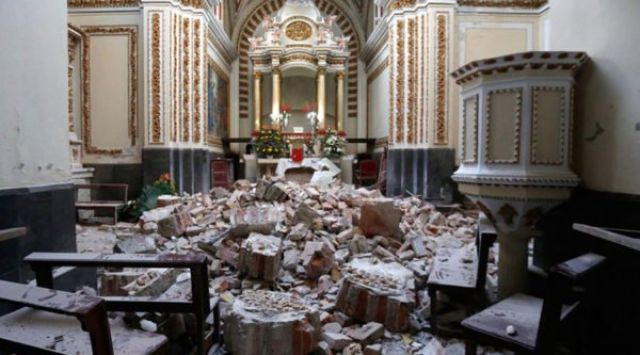
The earthquake that hit on September 19 made my whole apartment move from side to side, like a tiny old ship caught on reckless waves. I live in the old part of central Puebla, just 51 kilometres from the epicentre.
After the quake, I watched as crowds gathered in the middle of the street — normally a busy fish and vegetable market. Children were crying, people were a bit shaken, but they seemed okay. The next morning, I walked around the city, observing the large cracks and broken corners on some of the most historic and beautiful buildings.
Meanwhile, news from Mexico City, Morelos state and the smaller and the poorest towns was of churches that have caved in and crushed those inside, of collapsed schools which have so far left 37 kids and teachers killed, and of other buildings that have toppled near friends’ homes.
In Mexico City, several multi-storey buildings collapsed in on themselves, some bridges are unusable, and officials have counted more than 200 deaths so far, with 800 injured and 5 million left without electricity.
People overseas have expressed concern and in Puebla, most people have taken time off work or school to help distribute goods, clear rubble, or just do whatever they can for those who need. The extent to which people care is inspiring and some of the building collapses have been tragic.
But Mexico is dealing with bigger tragedies than this, though they are less social-media shareable than the footage of collapsing buildings.
When you walk around Puebla, particularly where I live and to the north — away from the touristic historic centre and into the poorer suburbs — you can see a lot of abandoned buildings, turned rubble, crater-like holes dot the roads, shops are falling apart, and the school where I teach is half dirt-floor, with just a rocky dirt road leading to it.
Street drainage doesn’t work, leading to landslides in the rainy season. Most of us get water for only 30 minutes a week. The poor parts of Puebla City and state, like much of Mexico, have been abandoned by the government and, in many ways, look like an earthquake already hit — and keeps on hitting.
Beyond this, there have been 83 femicides in Puebla so far this year, and almost 30,000 forced disappearances in the country over the past decade. And that is just the official figure, the reality is likely to be about five times that. There are 22 million Mexicans who don’t have tap water in their homes, and most Mexicans earn less than US$380 per month.
But there is no “mark yourself safe” button for domestic violence or the ongoing trauma of poverty. International concern about systemic inequality is more subdued.
Maybe it is just easier to help out in short bursts for natural disasters than for ongoing disasters, such as it being normal to work 13 hour days, six to seven days a week while the government fills its own pockets.
The September 19 earthquake came two weeks after an 8.2 earthquake hit more to the south of the country. Towns such as Jucitan were practically levelled, with 7000 damaged buildings for a population of 74,000 people.
People in Mexico City and other cities flooded to supply tents to donate goods, but in affected towns five days after the earthquake, residents complained they didn’t have anything to eat and had only been given water and blankets by the army. Most people left homeless were still sleeping in the street, and residents said the government was slow to even help clean up the rubble.
“The army doesn’t help us, they just march through, like a parade,” one resident who lost his home in Ixtaltepec, told La Vanguardia. In many cases, local and city mayors didn’t even visit their destroyed towns. Locals were forced to reach out through social media, pleading for help and for food.
Days after the earthquake, about 50 families sleeping in a sports court complained that they had only received one bottle of water from the local government. They said they needed food, water, mattresses, and nappies, and that anything the government had said about helping out was “just words”.
Since then, people have accused the various levels of government of distributing supplies as a political campaigning tool, in light of next year’s presidential elections. Non-governmental organisations that have been helping out in the area said that they observed how in the town of Ixhuatan, refuges set up all belonged to different political parties: to the PRI, PRD, and PAN.
In Juchitan and Union Hidalg, local police were reported to have stopped people from distributing goods to individual houses, only to then distribute those goods in the political parties’ refuges.
Despite almost all of these goods coming directly from Mexicans, “In San Francisco del Mar, as they handed out the provisions, they said it was help directly from Governor Alejandro Murat and his wife,” Juan Lopez, coordinator of one of the charities, told Reforma.
Juchitan mayor Gloria Sanchez has even been accused of keeping the provisions donated for herself and distributing them among friends, family and party supporters.
They say you can judge a society by its prisons, but you can also judge a government by its response to tragedy.
[Slightly abridged from The Real News. Reprinted with the author’s permission. Tamara Pearson is a journalist based in Latin America, an alternative pedagogy teacher and author of The Butterfly Prison. She blogs at Resistance Words.]